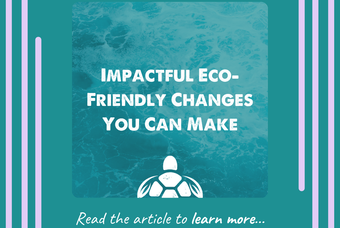The News-Hub/ Articles
Back to Articles
Recommended Articles
Impactful Changes to Make Your Home and Life More Eco-Friendly
It’s no secret that the world is facing an onslaught of environmental problems—food waste, biodiversity loss, plastic pollution, global warming from fossil fuels, air pollution, deforestation, and ocean acidification just to name a few. If we want to save the planet, we all need to step up and embrace an eco-friendly lifestyle. Together, we can drive change and protect the place we all call home. Here are some tips from Purple Turtle Co and Lisa Walker to help you live sustainably and make your home more eco-friendly!
Make Sustainable Upgrades to Boost Your Home Value
Besides supporting the environment, there are many great financial reasons to make your home more sustainable. For example, installing eco-friendly appliances, replacing your windows with energy-efficient models, investing in solar panels, and swapping your water heater for a tankless version can boost your home value. Be sure to keep track of any improvements you make so you can justify a higher appraisal value in the future. Appraisers welcome any information that will help them accurately determine the market value of your property, including receipts for upgrades and before and after photos of your improvements.
Buy an Eco-Friendly Home
Are you looking for a new home? Make it eco-friendly! Buying an eco-friendly home will save you from having to make expensive improvements yourself. At the same time, green homes tend to have lower utility costs and may even get you some tax rebates. If you think you might sell the home in the future, eco-friendly features will help you sell faster and for a higher listing price.
There are a couple of key things to look for when house-hunting for a sustainable living space. For example, Blue & Green Tomorrow suggests asking the seller about the materials used in construction and upgrades. Recycled steel, reclaimed wood, and precast concrete are more sustainable than other building materials. Underfloor heating, dual-pane windows, eco-friendly landscaping, LED lights, and high-quality insulation are all great signs. Bonus points if the home has solar panels!
Reduce Plastic Waste at Home
Reducing the amount of household waste your produce is one of the easiest and most affordable ways to support the environment. Plastic waste, in particular, is something we can all stand to produce less of. Stick to reusable items such as face towels, make-up removal cloths, kitchen rags, cloth shopping bags, reusable water bottles, glass containers, and reusable straws. You could even buy your pantry staples in bulk and bring your own containers to the store!
Compost and Recycle
Reducing your reliance on single-use plastics is the best way to reduce your waste, but recycling is a good backup option. In addition to recycling, consider composting your food scraps. Food waste that sits buried in the landfill produces methane, a harmful greenhouse gas. When food waste is composted in a special facility, it’s decomposed in a way that does not produce methane. Plus, the resulting compost can be used in farming to replenish nutrients in the soil and replace synthetic fertilizers.
Buy Used Whenever Possible
What’s better than recycling? Reusing! Buying something second-hand gives it a second life and saves it from the landfill. Not only that but purchasing something used means you won’t have to buy it new, saving the resources involved in the manufacturing process for that product. Thrift stores and online marketplace platforms like eBay and Facebook Marketplace are great for finding gently used furniture, appliances, clothing, toys, pet supplies, tools, tech, and home decor.
Don’t Support Brands That Hurt the Environment
While making all of these lifestyle changes is a great way to reduce your footprint, don’t forget who is really to blame. According to CDP, just 100 companies are responsible for over 70% of global carbon emissions! Changing our consumption patterns is the only power we have to encourage big corporations to shift to more sustainable production methods. When you can’t buy something used, shop from brands that support the environment. Just be careful to avoid greenwashing! Always do your own research instead of taking a brand’s claims at face value.
We can all do more to support the environment. Homeowners, in particular, have a lot of control over their carbon footprint and the amount of waste produced. Consider making upgrades to your home to reduce your use of fossil fuels. When possible, reuse items and buy second-hand. And when you can’t, compost and recycle instead of throwing everything in the trash. Make conscious spending decisions and support brands that care about the environment just as much as you do. If we all take steps to live more sustainably, we can make a difference!
Empty content. Please select category to preview











0 comments. Write a comment